Darina Štyriaková 1*; Timea Hajnal-Jafari 2; Vladimira Žunić 2; Jaroslav Šuba 1; Marta Prekopová 1; Ali Kaan Yetik 3; Iveta Štyriaková 1
1, Ekolive s.r.o., Americká trieda 3, 040 13 Kosice, Slovakia
2, Faculty of Agriculture, Department of Field and Vegetable Crops, University of Novi Sad, Dositeja Obradovića Sq. 8, 21000, Novi Sad, Serbia
3, Department of Biosystems Engineering, Faculty of Agricultural Sciences and Technologies, Niğde Ömer Halisdemir University, 51100, Niğde, Türkiye
E-mail:
darina.styriakova@ekolive.eu
Received: 26/06/2025
Acceptance: 22/08/2025
Available Online: 25/08/2025
Published: 01/01/2026
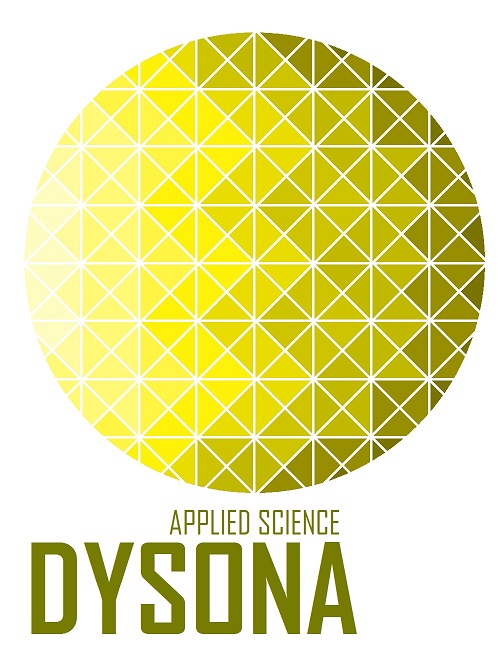
Manuscript link
http://dx.doi.org/10.30493/DAS.2025.531444
Abstract
This study aimed to assess the effects of biostimulant applications on both vegetative and generative growth, fruit characteristics, and yield of strawberry (Fragaria × ananassa Duch.) A total of ten treatments were implemented, comprising various combinations of Microfertile® plant (MP) and Ekofertile® plant (EP) biostimulants, with both full and 50% reduced NPK applications, alongside a control group that received solely NPK. The findings demonstrate that the application of biostimulants led to notable enhancements in plant height, leaf count, and flower yield, especially when utilized in conjunction with full NPK fertilization. The EP10% treatment exhibited the most significant vegetative growth parameters, resulting in the tallest plants and the greatest number of leaves, whereas the MP5% treatment achieved the highest flower count. The examination of fruit attributes revealed that the application of full NPK in conjunction with biostimulants resulted in fruits that exhibited increased size and weight, although the differences compared to other treatments were not statistically significant. The yield of strawberries exhibited significant variation among the treatments, with EP10% achieving the highest yield of 38.70 t ha-1, representing a 60.02% increase compared to the control group (24.18 t ha-1). Despite the observed decrease in yields associated with treatments featuring reduced NPK, the utilization of biostimulants successfully maintained productivity levels akin to those of the control group. The findings indicate that although optimal NPK levels are crucial for maintaining baseline growth and yield, the application of biostimulants markedly improves nutrient uptake efficiency and optimizes both vegetative growth and fruit yield. Further investigation is necessary to determine the mechanism through which the use of biostimulants may mitigate nutritional stress in strawberries.
Keywords: Strawberry, Biostimulants, Yield, Vegetative, Fertilization
Introduction
In recent years, there has been a substantial increase in the global demand for sustainable agricultural practices, which is primarily due to the necessity of preserving crop productivity while minimizing environmental impact. This change is primarily a response to the increasing apprehension regarding the detrimental consequences of traditional agricultural practices, which frequently depend on chemical fertilizers, pesticides, and intensive farming techniques [1]. Despite their effectiveness in increasing short-term yields, these practices have been demonstrated to contribute to a variety of environmental issues, including the loss of biodiversity, water pollution, and soil degradation [2]. Furthermore, the long-term sustainability of food production systems is imperiled by the decline in soil fertility, increased greenhouse gas emissions, and contamination of water resources, all of which have been associated with the excessive use of chemical inputs [3][4]. Conversely, the necessity for cutting-edge solutions that guarantee food security without further damaging the environment has been exacerbated by climate change and the growing global population. Agricultural systems will be under significant pressure to produce more food with less land, as food demand is expected to increase by 60% by 2050 [5-7]. This necessitates a delicate equilibrium between the preservation of the indispensable natural resources for future generations and the intensification of production [8].
In response to the aforementioned challenges, sustainable agricultural practices have emerged as a critical strategy for enhancing resilience in agroecosystems. These practices prioritize the preservation of resources, the improvement of biodiversity, and the reduction of external inputs, all while maintaining or enhancing yield levels [9]. The integration of eco-friendly inputs, such as biostimulants, biofertilizers, and biological pest control agents, is a critical component of sustainable agriculture. These inputs are designed to enhance plant health and productivity through natural processes, rather than relying solely on synthetic chemicals [10-12]. In this context, microbial biostimulants have become a critical instrument in modern agriculture, providing sustainable alternatives to conventional chemical inputs [13]. These formulations frequently contain beneficial microorganisms, such as bacteria and fungi, that establish symbiotic relationships with plants, thereby fostering root and shoot development and enhancing nutrient availability [14]. This biological approach is consistent with the increasing interest in environmentally friendly agricultural practices, which aim to reduce the dependence on synthetic fertilizers and pesticides, thereby reducing the adverse impacts of conventional farming on soil health and biodiversity [15].
The utilization of biostimulants has yielded substantial advantages for strawberry [16]. As a high-value crop, strawberries, are not only susceptible to environmental stresses such as drought, nutrient imbalances, and soil-borne diseases [17], but they also necessitate substantial inputs to sustain high yields and fruit quality. Chemical fertilizers are frequently employed in conventional strawberry cultivation to satisfy the high nutrient requirements of the crop, particularly in large-scale production systems [18]. The sustainability of strawberry production is ultimately jeopardized by the significant environmental dangers posed by this high level of chemical input, which include soil degradation, water contamination, and a reduction in biodiversity [19].
The reduction of the dependence on chemical fertilizers in strawberry cultivation is essential for the preservation of long-term soil health and the reduction of input costs for producers, in addition to minimizing environmental impacts. Biostimulants are a promising alternative or complement to traditional inputs, as they can significantly increase the bioavailability of essential minerals, enhance nutrient uptake, and increase plant resilience to biotic and abiotic stressors [14]. Biostimulants have the potential to enhance the vigor of plants, promote the production of phytohormones such as auxins, cytokinins, and gibberellins, which are critical regulators of plant growth, and result in larger fruit sizes and higher overall yields, particularly in strawberry production [20]. The reduction of fertilizer consumption while simultaneously maintaining or enhancing yield is of the utmost importance. Biostimulants provide a sustainable solution that has the potential to enhance the efficacy of nutrient use and potentially reduce the necessity for harmful chemical input [21]. In addition to promoting environmental sustainability, this transition to a more environmentally friendly approach guarantees that strawberry cultivation can continue to satisfy the growing global demand for high-quality fruit.
Based on the previous debates, the growth and yield of strawberries in Vojvodina, Serbia were examined in this study in relation to the effects of two microbial biostimulants under full and reduced nutrient application. The trial investigates the potential of these biostimulants to improve vegetative and generative growth parameters, particularly in conjunction with reduced mineral fertilizer applications.
Material and Methods
Experimental site and climatic conditions
The field trial was conducted in 2024 at the experimental site located in the village of Gospođinci, within the Vojvodina province of Serbia. The region is situated at a latitude of 45° 24′ 14.24″ N and a longitude of 19° 58′ 9.86″ E, at an elevation of 80 meters above sea level. Vojvodina is characterized by a temperate continental climate, with moderate winters and hot summers. Meteorological data from the Republic Hydrometeorological Service of Serbia reported the maximum rainfall (83.8 mm) in November 2023, while the average annual temperature was within typical ranges for the region. The soil at the experimental site was classified as slightly alkaline, with a pH ranging from 7.22 to 8.23. Agrochemical analyses indicated a moderate level of total carbonates (4.27%) and a high organic matter content, with humus concentration measured at 4.01%. Soil nutrient composition was as follows: total nitrogen (N) content of 0.20%, phosphorus (P2O5) content of 21.58 mg/100g, and potassium (K2O) content of 41.76 mg/100g. These values indicate that the soil was rich in essential macro-nutrients, providing a fertile substrate for crop cultivation.
Experimental design
A randomized blinded block design was employed to assess the efficacy of two microbial-based biostimulants: Microfertile® plant (MP) and Ekofertile® plant (EP), supplied by the Slovakia-based company Ekolive (Fig. 1 A). Both are organic liquid biostimulants produced via the InnoBioTech® ecological bioleaching process, which mimics the natural microbial weathering of minerals in the rhizosphere. This process solubilizes silicate, carbonate, oxides, and hydroxide minerals through microbial metabolism, liberating accessible macro and micronutrients in liquid form along with bioactive metabolites, including phytohormones and organic acids.
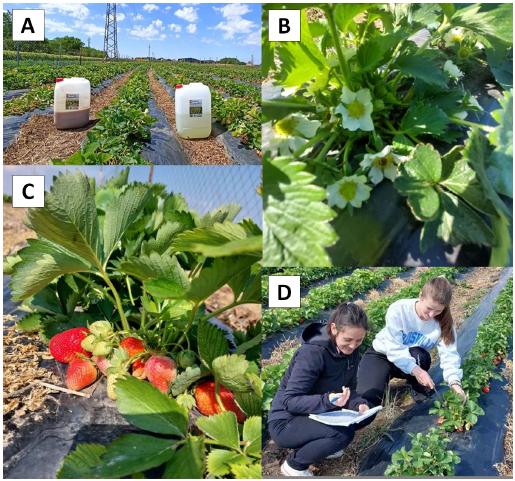
EP contains dissolved silicate minerals and probiotic bacteria (Lactobacillus spp.), producing a broad spectrum of phytohormones (cytokinins, auxins, jasmonates, abscisic acid, and phenolic compounds) as well as organic acids (lactic, acetic, phenyllactic) and fatty acids (butyric, isobutyric) at a pH of 3.8–4.8, supporting stress resilience, disease resistance, and improved root and shoot growth. On the other hand, MP is produced from silicate rock and contains microalgae (Chlorella spp.) along with sulfur-oxidizing and plant growth-promoting bacteria (Thiobacillus spp.), yielding metabolites such as valeric and isovaleric acids, antifreeze proteins, and phytohormones (cytokinins, auxins, jasmonates, phenolic compounds) at a pH of 7–8, enhancing photosynthesis, biomass accumulation, and tolerance to cold stress.
The total experimental plot covered an area of approximately 800 m2, with 10 different treatment groups, each occupying a 60 m2 plot (in total). Each treatment was replicated three times (20 m2 per block) to minimize variability due to environmental factors. The treatments included the application of biostimulants at two concentrations (5% and 10%), both alone and in combination with full NPK (F-NPK) (165 kg ha-1 15:15:15 NPK; 24.75 kg ha-1 N, 24.75 kg ha-1 P2O5, 24.75 kg ha-1 K2O) or reduced half NPK (50% NPK) (82.5 kg ha-1 15:15:15 NPK; 12.38 kg ha-1 N, 12.38 kg ha-1 P2O5, 12.38 kg ha-1 K2O) rates of mineral fertilizers. A control group was included, which received only full NPK (F-NPK) without biostimulants (Table 1).
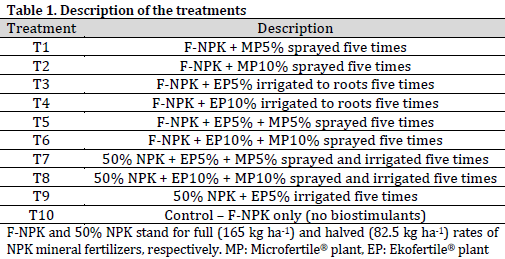
Plant material and cultivation practices
The strawberry (Fragaria × ananassa Duch.) cultivar “Clery” was selected as plant material. The variety is particularly resistant to common foliar diseases, such as mildew, and exhibits strong vegetative growth with large, dark green leaves [22].
The seedlings were planted in plastic mulch rows on August 12, 2023, and the trial commenced in March 2024. Herbicides (Glifol, 5 L ha-1) were applied between the rows on March 8, 2024, to control weed growth. Biostimulant treatments started on March 15, 2024, and were administered either as foliar sprays or via root irrigation, depending on the treatment group. Specifically, treatments containing only MP biostimulant (T1, T2) and the combination treatments (T5, T6) were applied to the foliage, while only EP treatments (T3, T4, T9) were irrigated directly to the root zone. Combination treatments T7 and T8 received both foliar (MP) and irrigation (EP) applications in accordance with the respective product type. The second application occurred on March 22, 2024, followed by the third on March 31, 2024. Subsequent applications took place during fruit growth (on April 15, 2024, and April 26, 2024) completing the biostimulant treatment schedule. Foliar applications were carried out using a calibrated “Womax” 16-liter sprayer, ensuring uniform coverage across all treatment groups.
Data collection and analysis
Vegetative and generative growth parameters were monitored. Vegetative parameters included plant height (measured in cm) and the number of leaves per rosette (Recorded on April 30, 2024), while generative parameters included the number of flowers per plant after the third biostimulant application (March 31, 2024). The harvest period started eight months after planting, between April 20, 2024 and May 20, 2024 (Fig. 3 B-D). Physical properties such as fruit length, width, and weight were measured using a caliper (Vorel, Poland) and technical scales, respectively. The average fruit yield per plant was calculated based on the total weight of harvested fruit converted to ton ha-1. An analysis of variance (ANOVA) was performed to determine significant differences across treatment groups. The Fisher’s Least Significant Difference (LSD) test was utilized to compare means of treatment at a significance level of p<0.05.
Results and Discussion
Vegetative and generative growth parameters
The application of biostimulants had a substantial impact on the vegetative growth of strawberries (P<0.05). The application of treatment T4 (F-NPK+EP10%) resulted in the tallest plants, achieving an average height of 29.56 cm, which indicates a 20% increase relative to the control group (F-NPK alone), which measured an average height of 24.63 cm. Similarly, the treatments T2 (F-NPK+MP10%) and T5 (F-NPK+EP5%+MP5%) led to an elevation in plant heights, recording measurements of 28.33 cm and 26.48 cm, respectively (Table 2). Previous reports indicated that biostimulants can significantly enhance plant growth even in suboptimal conditions, such as limited fertilization [23]. This observation aligns with the current results, where reduced NPK treatments (T7, T8, and T9) demonstrated a decent performance compared to the control group, as no significant differences were observed between these groups and T10 (F-NPK alone). However, the plant height did not achieve the levels seen in full NPK treatments supplemented with biostimulants.
The number of leaves per rosette exhibited a notable increase across various biostimulant treatments. The maximum leaf count was observed in T2, averaging 28.00 leaves, which notably surpassed the control group that displayed an average of 17.87 leaves. Moreover, T5 and T6 demonstrated a notable increase in leaf numbers, suggesting an improvement in plant vigor attributable to the application of biostimulants. According to the findings of Dong et al. [24], biostimulants promote plant growth by improving the development of both aerial and subterranean tissues. The present investigation reveals that various biostimulant applications, especially when utilized in conjunction, consistently enhanced aboveground growth, leading to an increase in plant height and a higher leaf count. This response is probably linked to enhanced root development, facilitating improved access to nutrients and water, which in turn supports the production of aboveground biomass.
The application of biostimulants significantly influenced generative growth. The treatment T1 (F-NPK+EP5%) exhibited the most significant flower count, with an average of 44.90 flowers per plant recorded. Subsequently, T4 (F-NPK+EP10%) exhibited an average of 43.43 flowers per plant, while T2 demonstrated an average of 38.03 flowers per plant. Conversely, the control group exhibited a markedly lower flower count, averaging 34.26 flowers per plant, thereby highlighting the beneficial impact of biostimulant application on flowering (Table 2). Experiments utilizing a 50% reduction in NPK, specifically treatments T7, T8, and T9, demonstrated a correlation with decreased plant height, leaf count, and flower yield compared to full NPK treatments. While biostimulants demonstrate beneficial outcomes, the importance of achieving optimal NPK levels is paramount for enhancing both vegetative and generative growth. Previous research observed that the use of biostimulants markedly improved vegetative growth metrics, emphasizing the advantages of integrating soil and foliar applications [16][25]. These findings align with the synergistic effects identified in this research, where the comprehensive application of NPK alongside biostimulants yielded enhanced growth results compared to reduced NPK treatments.
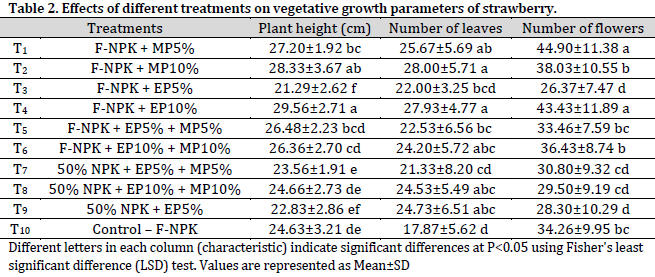
Although the role of plant biostimulants in mitigating stress has been extensively researched, there remains a paucity of information concerning their impact on fruit quality characteristics, including appearance and physical properties [26][27]. The treatments implemented did not yield statistically significant results regarding fruit height, fruit width, or fruit weight (P>0.05), indicating that these morphological characteristics remained largely unaffected under the tested experimental conditions. In the analysis of treatments, T5 yielded the longest fruits, measuring 4.14 cm, whereas T4 produced the widest fruits at 3.28 cm and the heaviest fruits, weighing 19.80 g. On the other hand, the control group (T10) recorded a fruit weight of 15.68 g (Table 3). Shakya et al. [28] noted an increase in the weight of strawberries when biostimulants were applied under mild drought conditions, which may indicate a reallocation of resources towards aerial growth and reproductive structures. This strategy is commonly utilized by plants experiencing moderate stress to secure reproductive success. Although no significant increase in fruit weight was observed in the current study, a notable rise in flower number and vegetative growth in plants treated with biostimulants was observed, especially when these were administered alongside complete NPK. This increase is likely attributed to improved nutrient and water utilization efficiency. This finding reinforces the notion that biostimulants promote an advantageous equilibrium between vegetative and generative growth.
In a similar vein, enhancements in fruit firmness and nutritional quality were observed as a result of biostimulant treatments [29]. While this study did not reveal any notable differences in fruit morphology and weight, reduced NPK treatments (T7, T8, and T9) did not result in a deterioration of fruit quality compared to full NPK control. In fact, higher (T7 and T9) or similar (T8) fruit weights were recorded in all three reduced NPK treatments compared to F-NPK. This might indicate that the use of biostimulants alleviated the nutritional stress imposed by reduced fertilization through the stimulation of secondary metabolite biosynthesis.
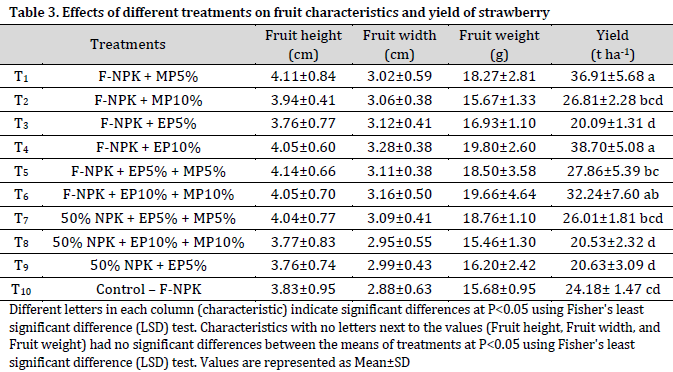
Strawberry yield
The yield of strawberries exhibited considerable variation across the different treatments (P<0.05) (Table 3). The maximum yields recorded were in T4 (38.70±5.08 t ha-1) and T1 (36.91±5.68 t ha-1), both of which demonstrated statistical superiority. The utilization of EP biostimulant at concentrations of 10% (T4) and 5% (T1), alongside comprehensive NPK fertilization, resulted in a notable increase in yield relative to alternative treatments, demonstrating a 60.02% and 52.61% enhancement in yield compared to the control, respectively.
Interestingly, all treatments that utilized a 50% reduction in NPK (T7, T8, T9) demonstrated yields that were comparable to those achieved with F-NPK alone. These results imply that biostimulants may offer a partial remedy for nutrient deficiency. Previously, it was demonstrated that the application of biostimulants to foliage effectively addressed nutrient deficiencies in strawberry plants, resulting in notable enhancements in biomass accumulation and yield [29]. The results corroborate the findings of this research, indicating that the application of EP and MP biostimulants markedly improved fruit yield, even under conditions of diminished NPK availability. The yield enhancements noted in this investigation, especially within the context of reduced NPK applications, can be linked to mechanisms including augmented root biomass and optimized nutrient absorption promoted by biostimulants [29]. Other reports demonstrated that the use of biostimulants led to notable enhancements in strawberry fruit yield when compared to the control group [30]. The plants subjected to treatment exhibited a superior average yield per individual specimen, with the combination of 30% reduced NPK and biostimulants demonstrating the most favorable outcomes. The findings indicate that biostimulants have the potential to alleviate the adverse effects associated with decreased fertilization on fruit yield.
Bacterial biostimulants play a significant role in nitrogen fixation and the synthesis of phytohormones, including auxins, which facilitate root elongation and branching. The current investigation revealed comparable outcomes with the utilization of EP and MP biostimulants, which markedly improved vegetative growth, encompassing heightened plant height and leaf count, in addition to overall yield enhancement. The application of biostimulants appears to have enhanced root development and nutrient uptake, resulting in more robust vegetative growth.
Further targeted investigations are necessary to explore the mechanisms through which these biostimulants promote strawberry growth at the molecular and biochemical levels. It is important to highlight that the soil utilized in the present study was inherently fertile and exceptionally conducive to strawberry cultivation, potentially obscuring the negative impact of diminished NPK application. Therefore, it is imperative that a broader range of experimental conditions be explored in subsequent studies to deepen the understanding of the beneficial impact of Lactobacillus spp., Chlorella spp., and Thiobacillus spp. biostimulants in mitigating nutritional stress, along with other forms of stress, as well as the mechanisms through which these biostimulants may elicit such responses.
Conclusions
The results of the study highlight the complementary roles of biostimulants and NPK in promoting the overall growth, fruit quality, and yield of strawberry. While NPK provides the essential baseline nutrients necessary for plant development, the addition of biostimulants significantly amplifies its effectiveness, particularly in enhancing vegetative and generative growth. In treatments where NPK was reduced by 50%, there was a notable decrease in plant height, leaf number, and flower production when compared to the application of full NPK with biostimulants. Nonetheless, plants treated with biostimulants in conditions of reduced NPK demonstrated comparable performance to that of control group receiving only NPK, highlighting their effectiveness in alleviating nutrient deficiencies. The application of biostimulants in conjunction with full-dose NPK resulted in the most significant vegetative and generative development, highlighting the critical role of their synergistic application for achieving optimal plant performance. A similar pattern was observed concerning yield, as a 50% reduction in NPK resulted in diminished fruit production; however, plants that received biostimulants consistently outperformed the control group. The highest yields were attained by utilizing a comprehensive NPK approach alongside biostimulants, thus confirming their synergistic role in boosting productivity.
Conflict of interest statement
Authors, Darina Štyriaková, Jaroslav Šuba, Marta Prekopová, and Iveta Štyriaková, are employees of Ekolive s.r.o., which manufactures the biostimulants tested in this study. All other authors declare no conflict of interest.
Funding statement
This research was supported by Ekolive s.r.o., which provided the biostimulant materials (Ekofertile® and Microfertile®) used in the study. The company had no role in the field trial execution, data collection, or statistical analyses, which were conducted independently under institutional regulations and ethical oversight of the University of Novi Sad.
Data availability statement
The authors declared that all used datasets will be available upon reasonable request from the corresponding author.
References
- Edwards CA. The importance of integration in sustainable agricultural systems. In Sustainable agricultural systems. CRC Press. 2020:249-64. DOI
- Tilman D, Balzer C, Hill J, Befort BL. Global food demand and the sustainable intensification of agriculture. Proc. Natl. Acad. Sci. U.S.A. 2011;108(50):20260-4. DOI
- Foley JA, Ramankutty N, Brauman KA, Cassidy ES, Gerber JS, Johnston M, Mueller ND, O’Connell C, Ray DK, West PC, Balzer C. Solutions for a cultivated planet. Nature. 2011;478(7369):337-42. DOI
- Pahalvi HN, Rafiya L, Rashid S, Nisar B, Kamili AN. Chemical fertilizers and their impact on soil health. In Microbiota and biofertilizers, Vol 2: Ecofriendly tools for reclamation of degraded soil environs. Cham: Springer International Publishing. 2021:1-20. DOI
- FAO. The future of food and agriculture – Trends and challenges. Rome. 2017.
- Van Dijk M, Morley T, Rau ML, Saghai Y. A meta-analysis of projected global food demand and population at risk of hunger for the period 2010–2050. Nat. Food. 2021;2(7):494-501. DOI
- Falcon WP, Naylor RL, Shankar ND. Rethinking global food demand for 2050. Popul. Dev. Rev. 2022;48(4):921-57. DOI
- Godfray HC, Beddington JR, Crute IR, Haddad L, Lawrence D, Muir JF, Pretty J, Robinson S, Thomas SM, Toulmin C. Food security: the challenge of feeding 9 billion people. Science. 2010;327(5967):812-8. DOI
- Pretty J. Agricultural sustainability: concepts, principles and evidence. Philos. Trans. R. Soc. B: Biol. Sci. 2008;363(1491):447-65. DOI
- Gupta S, Dikshit AK. Biopesticides: An ecofriendly approach for pest control. J. Biopestic. 2010;3(Special Issue):186.
- Du Jardin P. Plant biostimulants: Definition, concept, main categories and regulation. Sci. Hortic. 2015;196:3-14. DOI
- Kour D, Rana KL, Yadav AN, Yadav N, Kumar M, Kumar V, Vyas P, Dhaliwal HS, Saxena AK. Microbial biofertilizers: Bioresources and eco-friendly technologies for agricultural and environmental sustainability. Biocatal. Agric. Biotechnol. 2020;23:101487. DOI
- Calvo P, Nelson L, Kloepper JW. Agricultural uses of plant biostimulants. Plant Soil. 2014;383(1):3-41. DOI
- Brown P, Saa S. Biostimulants in agriculture. Front. Plant Sci. 2015;6:671. DOI
- Povero G, Mejia JF, Di Tommaso D, Piaggesi A, Warrior P. A systematic approach to discover and characterize natural plant biostimulants. Front. Plant Sci. 2016;7:435. DOI
- Soltaniband V, Brégard A, Gaudreau L, Dorais M. Biostimulants promote plant development, crop productivity, and fruit quality of protected strawberries. Agronomy. 2022;12(7):1684. DOI
- Zahedi SM, Hosseini MS, Fahadi Hoveizeh N, Kadkhodaei S, Vaculík M. Physiological and biochemical responses of commercial strawberry cultivars under optimal and drought stress conditions. Plants. 2023;12(3):496. DOI
- Kilic N. Synergistic effect of organic and biofertilizers on strawberry cultivation. Sustainability. 2023;15(10):8206. DOI
- Khan MN, Mobin M, Abbas ZK, Alamri SA. Fertilizers and their contaminants in soils, surface and groundwater. Encyclopedia of the Anthropocene. 2018;5:225-40. DOI
- Žunić V, Hajnal-Jafari T, Stamenov D, Djurić S, Tomić J, Pešaković M, Grohar MC, Stampar F, Veberic R, Hudina M, Jakopic J. Application of microalgae-based biostimulants in sustainable strawberry production. J. Appl. Phycol. 2024;36(3):1219-31. DOI
- Khan W, Rayirath UP, Subramanian S, Jithesh MN, Rayorath P, Hodges DM, Critchley AT, Craigie JS, Norrie J, Prithiviraj B. Seaweed extracts as biostimulants of plant growth and development. J. Plant Growth Regul. 2009;28(4):386-99. DOI
- Weissinger H, Spornberger A, Steffek R, Altenburger J, Stich K, Jezik K. Field resistance of early-ripening strawberry cultivars under different site conditions in Austria. Int. J. Fruit Sci. 2011;11(3):220-31. DOI
- Parađiković N, Teklić T, Zeljković S, Lisjak M, Špoljarević M. Biostimulants research in some horticultural plant species—A review. Food Energy Secur. 2019;8(2):e00162. DOI
- Dong C, Wang G, Du M, Niu C, Zhang P, Zhang X, Ma D, Ma F, Bao Z. Biostimulants promote plant vigor of tomato and strawberry after transplanting. Sci. Hortic. 2020;267:109355. DOI
- Mohamed MH. Effect of some growth stimulants on production and quality of strawberry transplants. Ann. Agric. Sci., Moshtohor. 2015;53(4):693-708. DOI
- Rodrigues M, Baptistella JL, Horz DC, Bortolato LM, Mazzafera P. Organic plant biostimulants and fruit quality—A review. Agronomy. 2020;10(7):988. DOI
- Garza-Alonso CA, Olivares-Sáenz E, González-Morales S, Cabrera-De la Fuente M, Juárez-Maldonado A, González-Fuentes JA, Tortella G, Valdés-Caballero MV, Benavides-Mendoza A. Strawberry biostimulation: From mechanisms of action to plant growth and fruit quality. Plants. 2022;11(24):3463. DOI
- Shakya R, Capilla E, Torres-Pagán N, Muñoz M, Boscaiu M, Lupuţ I, Vicente O, Verdeguer M. Effect of two biostimulants, based on Ascophyllum nodosum extracts, on strawberry performance under mild drought stress. Agriculture. 2023;13(11):2108. DOI
- Soppelsa S, Kelderer M, Casera C, Bassi M, Robatscher P, Matteazzi A, Andreotti C. Foliar applications of biostimulants promote growth, yield and fruit quality of strawberry plants grown under nutrient limitation. Agronomy. 2019;9(9):483. DOI
- Popović B, Engler M, Kovačić Đ, Herman G, Bukvić G, Ergović L. The influence of biostimulants on strawberries yield, nutritional and sensory fruit quality. Glas. zašt. bilja. 2022;45(6.):84-9. DOI
Cite this article:
Štyriaková, D., Hajnal-Jafari, T., Žunić, V., Šuba, J., Prekopová, M., Yetik, A. K., Štyriaková, I. Influence of biostimulant applications on vegetative growth and yield of strawberry under full and reduced fertilization. DYSONA – Applied Science, 2026;7(1): 41-49. doi: 10.30493/das.2025.531444

